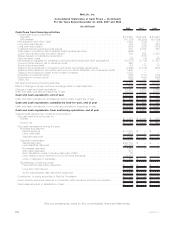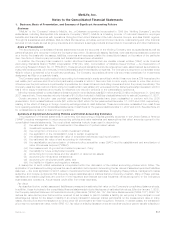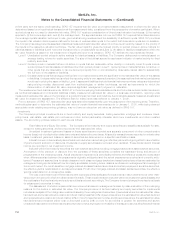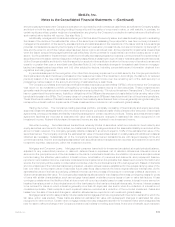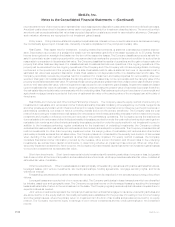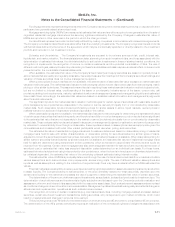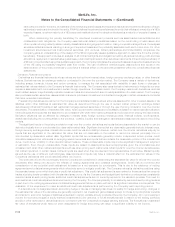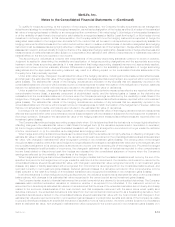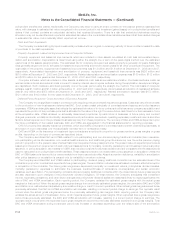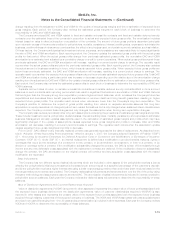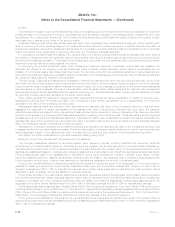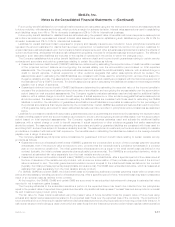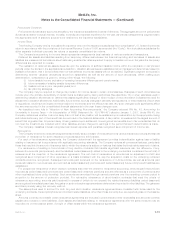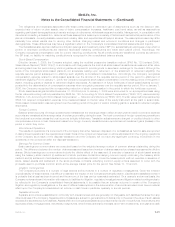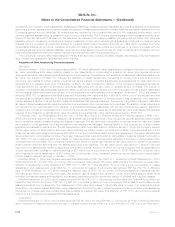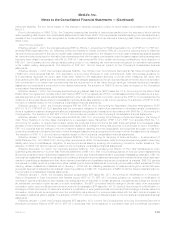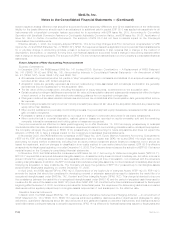MetLife 2008 Annual Report Download - page 139
Download and view the complete annual report
Please find page 139 of the 2008 MetLife annual report below. You can navigate through the pages in the report by either clicking on the pages listed below, or by using the keyword search tool below to find specific information within the annual report.Goodwill
Goodwill is the excess of cost over the estimated fair value of net assets acquired. Goodwill is not amortized but is tested for impairment
at least annually or more frequently if events or circumstances, such as adverse changes in the business climate, indicate that there may
be justification for conducting an interim test. The Company performs its annual goodwill impairment testing during the third quarter of each
year based upon data as of the close of the second quarter.
Impairment testing is performed using the fair value approach, which requires the use of estimates and judgment, at the “reporting unit”
level. A reporting unit is the operating segment or a business one level below the operating segment, if discrete financial information is
prepared and regularly reviewed by management at that level. For purposes of goodwill impairment testing, a significant portion of goodwill
within Corporate & Other is allocated to reporting units within the Company’s business segments.
For purposes of goodwill impairment testing, if the carrying value of a reporting unit’s goodwill exceeds its estimated fair value, there is
an indication of impairment and the implied fair value of the goodwill is determined in the same manner as the amount of goodwill would be
determined in a business acquisition. The excess of the carrying value of goodwill over the implied fair value of goodwill is recognized as an
impairment and recorded as a charge against net income.
In performing its goodwill impairment tests, when management believes meaningful comparable market data are available, the
estimated fair values of the reporting units are determined using a market multiple approach. When relevant comparables are not
available, the Company uses a discounted cash flow model. For reporting units which are particularly sensitive to market assumptions,
such as the annuities and variable & universal life reporting units within the Individual segment, the Company may corroborate its estimated
fair values by using additional valuation methodologies.
The key inputs, judgments and assumptions necessary in determining estimated fair value include projected earnings, current book
value (with and without accumulated other comprehensive income), the level of economic capital required to support the mix of business,
long term growth rates, comparative market multiples, the account value of in-force business, projections of new and renewal business as
well as margins on such business, the level of interest rates, credit spreads, equity market levels and the discount rate management
believes appropriate to the risk associated with the respective reporting unit. The estimated fair value of the annuity and variable & universal
life reporting units are particularly sensitive to the equity market levels.
When testing goodwill for impairment, management also considers the Company’s market capitalization in relation to its book value.
Management believes that the overall decrease in the Company’s current market capitalization is not representative of a long-term
decrease in the value of the underlying reporting units.
Management applies significant judgment when determining the estimated fair value of the Company’s reporting units and when
assessing the relationship of market capitalization to the estimated fair value of its reporting units and their book value. The valuation
methodologies utilized are subject to key judgments and assumptions that are sensitive to change. Estimates of fair value are inherently
uncertain and represent only management’s reasonable expectation regarding future developments. These estimates and the judgments
and assumptions upon which the estimates are based will, in all likelihood, differ in some respects from actual future results. Declines in the
estimated fair value of the Company’s reporting units could result in goodwill impairments in future periods which could materially adversely
affect the Company’s results of operations or financial position.
Management continues to evaluate current market conditions that may affect the estimated fair value of the Company’s reporting units
to assess whether any goodwill impairment exists. Continued deteriorating or adverse market conditions for certain reporting units may
have a significant impact on the estimated fair value of these reporting units and could result in future impairments of goodwill.
See Note 6 for further consideration of goodwill impairment testing during 2008.
Liability for Future Policy Benefits and Policyholder Account Balances
The Company establishes liabilities for amounts payable under insurance policies, including traditional life insurance, traditional
annuities and non-medical health insurance. Generally, amounts are payable over an extended period of time and related liabilities are
calculated as the present value of future expected benefits to be paid reduced by the present value of future expected premiums. Such
liabilities are established based on methods and underlying assumptions in accordance with GAAP and applicable actuarial standards.
Principal assumptions used in the establishment of liabilities for future policy benefits are mortality, morbidity, policy lapse, renewal,
retirement, disability incidence, disability terminations, investment returns, inflation, expenses and other contingent events as appropriate
to the respective product type. Utilizing these assumptions, liabilities are established on a block of business basis.
Future policy benefit liabilities for participating traditional life insurance policies are equal to the aggregate of (i) net level premium
reserves for death and endowment policy benefits (calculated based upon the non-forfeiture interest rate, ranging from 3% to 7% for
domestic business and 3% to 10% for international business, and mortality rates guaranteed in calculating the cash surrender values
described in such contracts); and (ii) the liability for terminal dividends.
Future policy benefits for non-participating traditional life insurance policies are equal to the aggregate of the present value of expected
future benefit payments and related expenses less the present value of expected future net premiums. Assumptions as to mortality and
persistency are based upon the Company’s experience when the basis of the liability is established. Interest rates assumptions for the
aggregate future policy benefit liabilities range from 2% to 8% for domestic business and 2% to 12% for international business.
Participating business represented approximately 8% and 9% of the Company’s life insurance in-force, and 14% and 14% of the number
of life insurance policies in-force, at December 31, 2008 and 2007, respectively. Participating policies represented approximately 27% and
27%, 31% and 30%, and 30% and 29% of gross and net life insurance premiums for the years ended December 31, 2008, 2007 and 2006,
respectively. The percentages indicated are calculated excluding the business of the reinsurance segment.
Future policy benefit liabilities for individual and group traditional fixed annuities after annuitization are equal to the present value of
expected future payments. Interest rates assumptions used in establishing such liabilities range from 2% to 11% for domestic business and
4% to 10% for international business.
F-16 MetLife, Inc.
MetLife, Inc.
Notes to the Consolidated Financial Statements — (Continued)


